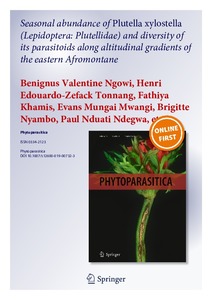| dc.contributor.author | Ngowi, B.V. |
| dc.contributor.author | Tonnang, H.E.Z. |
| dc.contributor.author | Khamis, F. |
| dc.contributor.author | Mwangi, E.M. |
| dc.contributor.author | Nyambo, B. |
| dc.contributor.author | Ndegwa, P.N. |
| dc.contributor.author | Subramanian, S. |
| dc.date.accessioned | 2019-12-04T11:36:16Z |
| dc.date.available | 2019-12-04T11:36:16Z |
| dc.date.issued | 2019-07 |
| dc.identifier.citation | Ngowi, B.V., Tonnang, H.E.Z., Khamis, F., Mwangi, E.M., Nyambo, B., Ndegwa, P.N. & Subramanian, S. (2019). Seasonal abundance of Plutella xylostella (Lepidoptera: Plutellidae) and diversity of its parasitoids along altitudinal gradients of the eastern Afromontane. Phytoparasitica, 47(3), 375–391. |
| dc.identifier.issn | 0334-2123 |
| dc.identifier.uri | https://hdl.handle.net/20.500.12478/6177 |
| dc.description | Published online: 25 June 2019 |
| dc.description.abstract | Monthly field surveys of diamondback moth (DBM), Plutella xylostella (L.) and its parasitoids were conducted to assess seasonal abundance and diversity under changing altitude. Twenty-four crucifer farms spread across three altitudinal zones of Mount Kilimanjaro and Taita hills were sampled for the insects at monthly interval from 2013 to 2014. Diamondback moth abundance differed significantly between seasons (F3, 21 = 3.883, p = 0.024) in the high zone of Taita hills. The abundance among altitudinal zones of the two transects was not significantly different (Mt. Kilimanjaro: F2, 98 = 0.415, p = 0.661; Taita hills: F2, 116 = 0.303, p = 0.739). Eight parasitoid species emerged in the laboratory from collected DBM larvae and pupae. Cotesia vestalis (Haliday) provided the most DBM parasitism in the low zone and Diadegma semiclausum (Hellen) in the medium and high zones. Parasitism by D. semiclausum increased by 32.5% between the low and medium zones (p = 0.001) of Taita hills. Diversity of parasitoid species declined considerably from the low to medium zones of Taita hills. The diversity of wild crucifer species increased with altitude but was twice as diverse in the high zone of Mt. Kilimanjaro than the high zone of Taita hills. Ecological complexity of the cropping system contributed greatly to a wider parasitoid diversity along Mt. Kilimanjaro. The introduced C. vestalis has successfully established in East Africa and adapted to the warmer areas in the low altitudes. |
| dc.description.sponsorship | Ministry of Foreign Affairs, Finland |
| dc.description.sponsorship | United Kingdom Aid |
| dc.description.sponsorship | Swedish International Development Cooperation Agency |
| dc.description.sponsorship | Swiss Agency for Development and Cooperation |
| dc.description.sponsorship | Federal Ministry for Economic Cooperation and Development, Germany |
| dc.description.sponsorship | Governmen of Kenya |
| dc.format.extent | 375–391 |
| dc.language.iso | en |
| dc.rights | Copyrighted; all rights reserved |
| dc.subject | Diadegma Semiclausum |
| dc.subject | Plutella Xylostella |
| dc.subject | Parasitoids |
| dc.subject | Tanzania |
| dc.title | Seasonal abundance of Plutella xylostella (Lepidoptera: Plutellidae) and diversity of its parasitoids along altitudinal gradients of the eastern Afromontane |
| dc.type | Journal Article |
| dc.description.version | Peer Review |
| cg.contributor.affiliation | International Centre of Insect Physiology and Ecology |
| cg.contributor.affiliation | University of Nairobi |
| cg.contributor.affiliation | Tropical Pesticides Research Institute, Tanzania |
| cg.contributor.affiliation | International Maize and Wheat Improvement Center |
| cg.contributor.affiliation | International Institute of Tropical Agriculture |
| cg.coverage.region | Africa |
| cg.coverage.region | East Africa |
| cg.coverage.country | Tanzania |
| cg.isijournal | ISI Journal |
| cg.authorship.types | CGIAR and developing country institute |
| cg.iitasubject | Pests Of Plants |
| cg.journal | Phytoparasitica |
| cg.howpublished | Formally Published |
| cg.accessibilitystatus | Limited Access |
| local.dspaceid | 106553 |
| cg.targetaudience | Scientists |
| cg.identifier.doi | https://dx.doi.org/10.1007/s12600-019-00732-3 |

